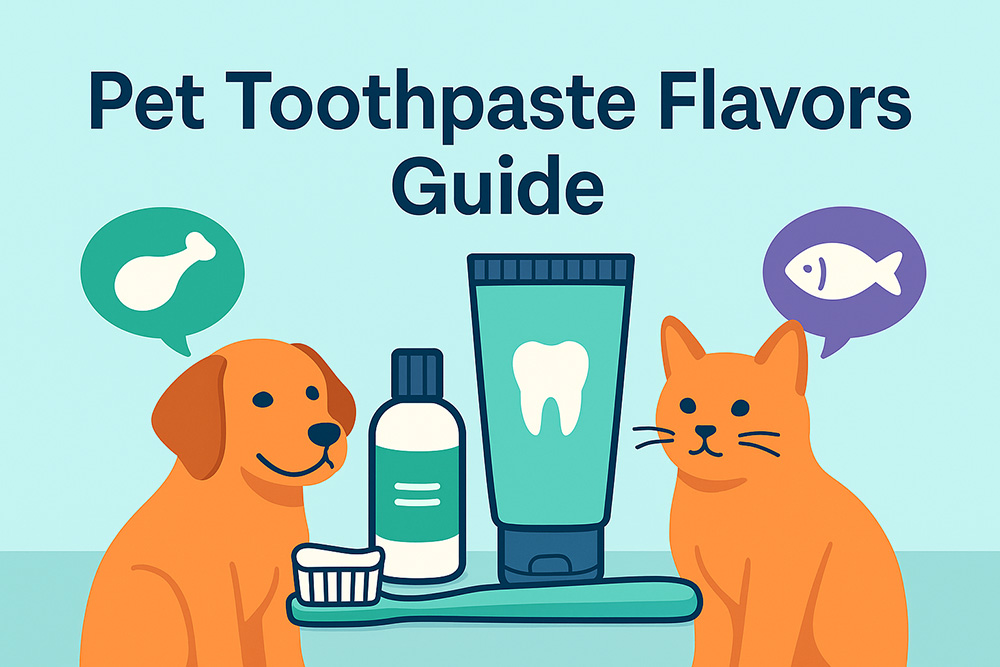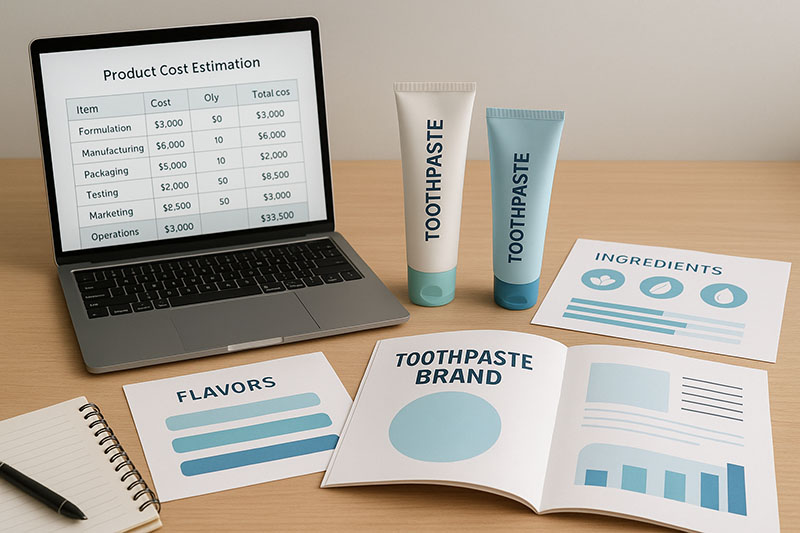Pet Toothpaste Flavors Manufacturers Recommend Most

Daily brushing is still the gold standard for home dental care in pets. Flavor does not clean teeth by itself, but the right flavor makes daily brushing possible. That is why flavor strategy matters for both pet parents and brands.
This guide blends consumer insight with a manufacturer’s view. You will find a flavor matrix for dogs and cats, safety flags, simple selection steps, and an OEM workflow you can use to brief suppliers.
Why flavors matter
Flavor acceptance drives compliance. Pets will not rinse and spit, so we rely on taste to build a positive brushing habit. Veterinary groups recommend frequent plaque removal at home; flavor makes that habit stick.
Enzymatic and antiseptic actives can support plaque control, but they only work when used as directed. Flavor helps owners brush often enough to see benefit.
Snippet — Quick definition: Pet toothpaste flavors are palatable, pet-safe aromas and tastes that improve brushing acceptance without adding sugar or unsafe sweeteners.
Dog and cat taste basics
Dogs have more taste buds than cats and accept a wider range of flavors, especially meaty notes. Cats lack a functional sweet-taste receptor (T1R2), so “sweet” profiles rarely help with felines. Meat and fish notes tend to work better.
Mint is popular with humans. It is not a universal win for pets. Some dogs tolerate mild mint or vanilla-mint, but many still prefer poultry or peanut butter. Cats often ignore mint entirely.
Safety and compliance basics
Choose pet toothpaste made for dogs or cats. Do not use human toothpaste. Human products may contain xylitol, fluoride, and foaming agents that pets swallow, which can be harmful.
Avoid concentrated essential oils in pet oral products, especially for cats. Peppermint, tea tree, wintergreen and others can be toxic to cats; use vet-formulated flavors only.
If you want independent efficacy screening, look for the VOHC Seal of Acceptance on oral gels and toothpastes. VOHC reviews data showing plaque or tartar reduction.
Non-medical advice: This article offers product design and buying guidance. It does not replace a veterinary diagnosis or treatment plan.
Core flavor families
Savory meats
Poultry
Most accepted dog flavor; also works for many cats. Available in many enzymatic pastes.
Beef
Popular in dogs; less useful for cats.
Seafood
Effective with many cats; acceptable for some dogs.
Plant and dessert notes
Peanut butter
High dog acceptance if peanut/nut allergies are not a household risk. Ensure strictly xylitol-free.
Vanilla or vanilla-mint
Used by several brands; perceived as “clean” by owners. Acceptance varies by pet. (Sources — Virbac flavors; independent reviews.)
Unflavored or bland
Best for very picky pets or allergy management. Useful in clinical settings.
Novel and niche
Herbal, blueberry, coconut
Emerging concepts in consumer content. Use care with essential oils and strong botanicals, especially in cats. Test acceptance before scaling.
Formulation building blocks
Lidercare develops both fluoride-free and veterinary-grade toothpaste bases for pets. Typical systems include:
Base: water, humectants (glycerin, sorbitol), thickener (xanthan, cellulose), mild abrasives (hydrated silica, dicalcium phosphate) adjusted for pet dentition.
Actives:
Enzymatic: glucose oxidase + lactoperoxidase to support an antimicrobial system.
Chlorhexidine: reserved for gels or short courses; the most effective plaque inhibitor but can affect taste; use under veterinary direction.
Zinc salts, CPC: breath support; watch bitterness.
Hydroxyapatite (HAp): non-peroxide enamel care approach under evaluation in veterinary products; conservative claims only.
Surfactants: low-foaming or none; avoid SLS to reduce GI upset risk in pets that swallow.
Flavors: food-grade, pet-safe, free from xylitol and high-risk essential oils.
Preservation: mild, pet-safe preservatives; pH targeting for stability.
Brushing itself is the main driver of plaque control; toothpaste enhances the effect and improves acceptance. (Source — Watanabe et al. on brushing vs toothpaste in dogs.)
Flavor selection matrix
Use this matrix to pick a starting point. Adjust after a 7–10 day home trial.
| Pet profile | High-probability flavors | Avoid or use with care | Notes |
|---|---|---|---|
| Adult dog, no allergies | Poultry, beef, peanut butter, vanilla-mint | Strong mint only if dog already accepts it | Start with poultry; switch if pet resists by day 3–4. |
| Puppy >12 weeks | Poultry, peanut butter | Any essential-oil heavy mint | Keep textures soft; pea-size amount. |
| Senior dog, picky | Peanut butter, poultry, unflavored | Bitter zinc heavy profiles | Choose higher humectant for mouthfeel. |
| Adult cat | Poultry, seafood | Sweet or mint profiles; essential oils | Cats lack sweet receptor; fishy notes win more often. |
| Cat with sensitivities | Unflavored, mild poultry | Mint, strong botanicals | Trial tiny smears to test acceptance. |
| Multi-pet home | Poultry, unflavored | Nut flavors if human peanut allergy risk | Select a single flavor most pets accept. |
Dogs versus cats flavor strategy
Dogs
Start with poultry. If rejected twice, switch to peanut butter or beef.
Consider vanilla-mint if the owner wants a “fresh” smell and the dog already tolerates mint treats.
For sensitive stomachs, try an unflavored gel.
Cats
Start with poultry or seafood.
Skip sweet flavors; they add no benefit.
Use tiny smears on a cotton swab before moving to a finger brush.
Ingredient watchlist
Xylitol: never in pet toothpaste. Check labels and supplier specs.
Fluoride: avoid in pet toothpastes; pets swallow paste.
Essential oils: avoid concentrated mint and phenolic oils, especially for cats.
Strong bitterness: chlorhexidine, zinc; use flavor-masking as needed.
Flavor and efficacy
Flavor does not replace brushing. Toothpaste with enzymes or antiseptic actives can help reduce plaque formation when combined with mechanical brushing.
If you prefer third-party screening, Petsmile Professional is a VOHC-accepted toothpaste option in the U.S. That seal reflects plaque reduction under VOHC protocols.
Featured snippet checklist
Flavor selection steps for pet toothpaste:
Confirm species and any allergies.
Start with poultry for dogs and cats; seafood for cats that reject poultry.
If dog rejects poultry, trial peanut butter or beef; if owner prefers “fresh,” try vanilla-mint.
For cats, avoid mint and sweet profiles; consider unflavored.
Screen labels for xylitol-free, fluoride-free, and no concentrated essential oils.
Run a 7–10 day home trial; switch if acceptance is poor by day 4–5.
For efficacy assurance, check VOHC acceptance on gels/pastes.
Common mistakes and fixes
Buying mint for cats: Cats rarely respond; switch to poultry or seafood.
Using human toothpaste: Risk of xylitol and fluoride ingestion; replace with pet-specific paste.
Ignoring bitterness: Some antiseptics taste bitter; add palatants or pick an enzymatic base.
Skipping training: Introduce with a smear on a finger; then a finger brush; then a small brush. Aim for short, calm sessions.
At home routine
Brush daily if possible; several times each week still helps. Use a pea-size amount, focusing on the gumline. Follow with a chew or fresh water.
For owners who cannot brush daily, an enzymatic gel plus VOHC-accepted chews and water additives can support oral care, but they do not replace brushing.
Manufacturing view flavor and formula
Flavor brief
Species and target segments: puppy, adult, senior; cat adult/senior.
Flavor family: poultry, beef, seafood, peanut butter, vanilla-mint, unflavored.
Allergen policy: nut-free line? cross-contact controls?
Claim scope: palatability, “enzymatic,” VOHC-tested variant, vet-recommended, cruelty-free policy.
Safety constraints: xylitol-free; fluoride-free; avoid high-risk essential oils; pet-safe preservatives.
Base selection
Enzymatic gel: glucose oxidase + lactoperoxidase; mild taste; multiple flavors.
Chlorhexidine gel: for veterinary lines; flavor-masking needed; label guidance for use.
HAp gel: emerging non-peroxide option; conservative benefit language.
Abrasivity
Use gentle abrasives; target low RDA-equivalent since pets swallow paste. For small breeds and cats, softer bristle brushes reduce aversion.
Palatants and masking
Hydrolyzed poultry or fish palatants raise acceptance. For plant notes, use low-intensity, GRAS-status flavors designed for pet ingestion; avoid concentrated oils in cats.
Stability and packaging
Tubes: sugarcane-based PE, recyclable HDPE, or aluminum barrier tubes for flavor retention.
Pumps: good for clinics; include backflow protection.
Lot controls: ISO-aligned batch records; retain samples; accelerated and real-time stability with taste checks.
Labeling and claims
Use conservative, accurate claims and follow local rules. In the EU and UK, pet grooming/oral products are not “cosmetics” in law for humans and follow other frameworks; avoid human-cosmetic claim language.
If you want third-party acceptance for efficacy, plan a VOHC program for at least one SKU.
Dogs and cats acceptance playbook
Week 1: smear taste trial; reward after a 10–20 second gumline swipe.
Week 2: finger brush with pea-size amount; two quadrants per session.
Week 3: soft-bristle pet brush; complete mouth in 45–60 seconds.
If rejection occurs: switch flavor; reduce amount; shorten sessions.
Comparison with market coverage
Many articles list popular flavors and name best-seller SKUs. Few connect flavor choice to species biology, safety flags, and OEM steps. This guide adds:
A species-specific matrix and an actionable selection checklist.
Clear safety guardrails (xylitol, fluoride, essential oils).
A manufacturer workflow to brief suppliers and plan VOHC.
FAQs on pet toothpaste flavors
What flavors do dogs like most
Poultry and peanut butter are strong starters. Beef and vanilla-mint follow. Start with poultry; switch if the dog resists.
What flavors do cats accept
Poultry and seafood lead. Cats lack a sweet receptor, so sweet-leaning flavors add little benefit.
Is mint safe for pets
Mild, vet-formulated mint flavors are used in some dog pastes, but avoid concentrated essential oils, especially for cats. When in doubt, pick poultry or unflavored.
Why avoid xylitol
Xylitol can be poisonous to dogs even in small amounts. Always check labels and specification sheets.
Do flavors change efficacy
No. Brushing provides the primary benefit. Choose flavors that your pet accepts so you can brush daily. For proven product efficacy, look for VOHC-accepted options.
Can I use human toothpaste flavors for pets
No. Human toothpaste often contains fluoride and xylitol and is not designed to be swallowed by pets. Use a pet-specific paste. (
How big should each dose be
A pea-size amount is enough for small dogs and cats; adjust up for large dogs. Focus on the gumline.
OEM and ODM workflow
Discovery
Define species, life stage, primary flavors, and any allergens to avoid.
Select base (enzymatic, chlorhexidine gel for vet, HAp).
Decide your VOHC plan for at least one hero SKU.
Bench and pilot
Develop 2–3 flavor variants per species.
Screen for bitterness and aftertaste; include masking and palatant trials.
Run 8-week stability at ambient and 40 °C with flavor paneling.
Home acceptance test
7–10 day in-home trial with diary scoring: acceptance (lick), tolerance (no GI upset), and ease of use.
Pivot flavor based on ≥70% acceptance threshold.
Scale up and quality
Finalize specs; allergen and contaminant screens; micro limits.
ISO-aligned batch records; retain samples; QC taste check on every lot.
Packaging: recyclable tubes, food-contact inks, tamper-evident caps.
Label and claims
Xylitol-free, fluoride-free, species-specific statements.
Conservative, evidence-based claims; link to brushing instructions and VOHC status where applicable.
Try Lidercare Now!
We Help You Launch New Products, And Continue To Grow. Try Us With 20% Off Your First Order!
Sustainability options
Sugarcane-based or recycled-content PE tubes to cut fossil plastic.
Aluminum barrier tubes for stronger aroma retention and recyclability.
Concentrated gels to reduce pack size and freight weight.
Paperboard outers with water-based coatings.
What to avoid in pet toothpaste flavor development
Xylitol or sugar alcohol sweeteners marketed for human dental use.
High-load essential oils, especially in cat SKUs.
Human-cosmetic style claims in EU/UK markets for pet products.
Assuming mint equals “freshness” for pets. Owner appeal ≠ pet acceptance; test first.
Request OEM samples from Lidercare — Share your target species and 2–3 preferred flavors. We will provide acceptance prototypes, ingredient lists, and a formulation sheet. Looking to build a VOHC path or a vet-exclusive line? Discuss private-label formulas with our R&D team.
Table of Contents
Awesome! Share to:
Latest Blog Posts
Check out the latest industry trends and take inspiration from our updated blogs, giving you a fresh insight to help boost your business.



